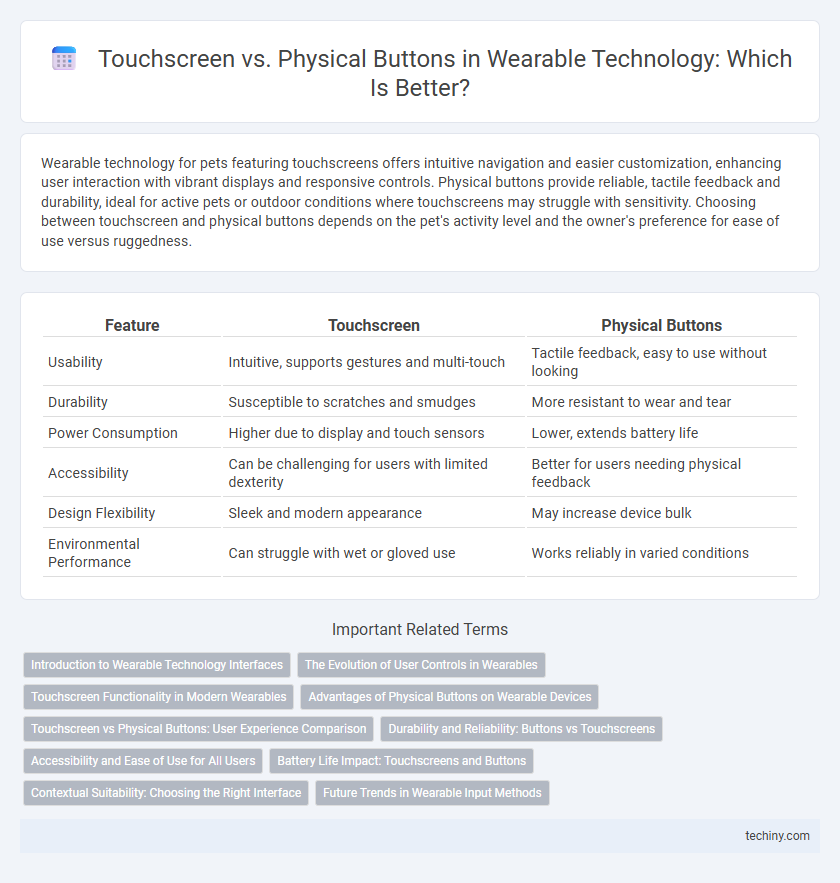Wearable technology for pets featuring touchscreens offers intuitive navigation and easier customization, enhancing user interaction with vibrant displays and responsive controls. Physical buttons provide reliable, tactile feedback and durability, ideal for active pets or outdoor conditions where touchscreens may struggle with sensitivity. Choosing between touchscreen and physical buttons depends on the pet's activity level and the owner's preference for ease of use versus ruggedness.
Table of Comparison
| Feature | Touchscreen | Physical Buttons |
|---|---|---|
| Usability | Intuitive, supports gestures and multi-touch | Tactile feedback, easy to use without looking |
| Durability | Susceptible to scratches and smudges | More resistant to wear and tear |
| Power Consumption | Higher due to display and touch sensors | Lower, extends battery life |
| Accessibility | Can be challenging for users with limited dexterity | Better for users needing physical feedback |
| Design Flexibility | Sleek and modern appearance | May increase device bulk |
| Environmental Performance | Can struggle with wet or gloved use | Works reliably in varied conditions |
Introduction to Wearable Technology Interfaces
Wearable technology interfaces primarily include touchscreen displays and physical buttons, each offering distinct user experiences. Touchscreens provide intuitive, gesture-based navigation ideal for complex interactions, while physical buttons enable reliable tactile feedback suited for quick, precise control in active environments. The choice between these interfaces depends on usability requirements, device form factor, and user context within wearable tech applications.
The Evolution of User Controls in Wearables
Touchscreen technology in wearable devices has revolutionized user controls by enabling intuitive gestures and customizable interfaces, enhancing interaction flexibility compared to traditional physical buttons. Physical buttons, once the primary method for navigation, offer tactile feedback and reliability in varied environmental conditions, maintaining relevance in specific use cases like fitness tracking during intense activities. The evolution from physical buttons to advanced touchscreens reflects a shift towards seamless user experiences, integrating haptic feedback and voice commands for enhanced accessibility and control in modern wearable technology.
Touchscreen Functionality in Modern Wearables
Touchscreen functionality in modern wearables offers intuitive gesture control, enabling seamless navigation through apps and notifications with simple swipes and taps. Capacitive touchscreens provide high responsiveness and multi-touch capabilities, enhancing user interaction and customization options without bulk. This technology supports advanced features like haptic feedback and adaptive brightness, improving usability in various lighting conditions and physical activities.
Advantages of Physical Buttons on Wearable Devices
Physical buttons on wearable devices deliver precise tactile feedback, enabling users to operate the device confidently without looking, which is crucial during activities like running or cycling. They offer reliable performance in diverse environmental conditions where touchscreens may fail, such as wet, sweaty, or gloved hands. Physical controls also consume less power than touchscreens, extending battery life and enhancing overall device durability in rugged or outdoor settings.
Touchscreen vs Physical Buttons: User Experience Comparison
Touchscreens on wearable devices offer intuitive navigation and versatile input options, enhancing user experience through gesture controls and customizable interfaces. Physical buttons provide tactile feedback and reliability in outdoor or wet conditions, ensuring precise operation without looking at the device. Both input methods impact usability, with touchscreens favored for modern, sleek designs and buttons preferred for durability and accessibility during active use.
Durability and Reliability: Buttons vs Touchscreens
Physical buttons on wearable technology often offer superior durability and reliability in harsh environments, with mechanical parts designed to withstand repeated presses and exposure to elements like moisture and dirt. Touchscreens, while sleek and versatile, can suffer from reduced responsiveness or damage due to scratches, water intrusion, and impact, potentially compromising device functionality. Devices intended for rugged use or outdoor activities benefit from reinforced buttons, ensuring consistent performance where touchscreen sensitivity might be compromised.
Accessibility and Ease of Use for All Users
Touchscreen interfaces on wearable technology offer customizable accessibility features such as adjustable text size and voice commands, enhancing ease of use for users with varying abilities. Physical buttons provide tactile feedback that benefits users with limited dexterity or visual impairments, ensuring reliable operation without relying on visual cues. Combining touchscreen capabilities with physical buttons creates an inclusive design that addresses diverse user needs for optimal accessibility and functionality.
Battery Life Impact: Touchscreens and Buttons
Touchscreens on wearable technology typically consume more battery power than physical buttons due to constant screen illumination and touch sensor activation. Physical buttons require minimal energy as they only draw power during the act of pressing, contributing to longer battery life in devices emphasizing navigation or control via buttons. Optimizing battery consumption in wearables often involves balancing touchscreen responsiveness with the energy efficiency of physical button inputs.
Contextual Suitability: Choosing the Right Interface
Touchscreen interfaces offer versatile control and customizable displays ideal for dynamic environments, while physical buttons provide tactile feedback crucial for users in motion or wearing gloves. Contextual suitability depends on usage scenarios; touchscreens excel in detailed navigation and visual interaction, whereas physical buttons ensure reliable operation under challenging conditions. Selecting the right interface enhances user experience by aligning device functionality with specific activity demands.
Future Trends in Wearable Input Methods
Future wearable technology favors advanced touchscreen interfaces integrated with haptic feedback to enhance user interaction, enabling more precise and intuitive control. Emerging innovations include flexible OLED displays and gesture-recognition sensors that reduce reliance on physical buttons, promoting seamless and ergonomic designs. AI-driven adaptive input methods will further customize user experiences, improving accessibility and efficiency in wearable devices.
Touchscreen vs Physical Buttons Infographic

 techiny.com
techiny.com